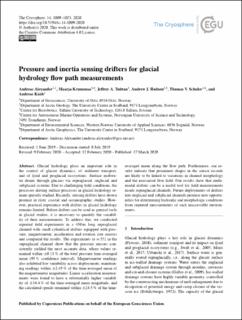| dc.contributor.author | Alexander, Andreas | |
| dc.contributor.author | Kruusmaa, Maarja | |
| dc.contributor.author | Tuhtan, Jeffrey | |
| dc.contributor.author | Hodson, Andrew | |
| dc.contributor.author | Schuler, Thomas | |
| dc.contributor.author | Kääb, Andreas | |
| dc.coverage.spatial | Svalbard | en_US |
| dc.date.accessioned | 2020-06-03T10:21:33Z | |
| dc.date.available | 2020-06-03T10:21:33Z | |
| dc.date.created | 2020-03-17T16:09:55Z | |
| dc.date.issued | 2020 | |
| dc.identifier.citation | Alexander, A., Kruusmaa, M., Tuhtan, J. A., Hodson, A. J., Schuler, T. V., & Kääb, A. (2020). Pressure and inertia sensing drifters for glacial hydrology flow path measurements. The Cryosphere, 14(3), 1009-1023. | en_US |
| dc.identifier.issn | 1994-0416 | |
| dc.identifier.uri | https://hdl.handle.net/11250/2656327 | |
| dc.description.abstract | Glacial hydrology plays an important role in the control of glacier dynamics, of sediment transport, and of fjord and proglacial ecosystems. Surface meltwater drains through glaciers via supraglacial, englacial and subglacial systems. Due to challenging field conditions, the processes driving surface processes in glacial hydrology remain sparsely studied. Recently, sensing drifters have shown promise in river, coastal and oceanographic studies. However, practical experience with drifters in glacial hydrology remains limited. Before drifters can be used as general tools in glacial studies, it is necessary to quantify the variability of their measurements. To address this, we conducted repeated field experiments in a 450 m long supraglacial channel with small cylindrical drifters equipped with pressure, magnetometer, acceleration and rotation rate sensors and compared the results. The experiments (n=55) in the supraglacial channel show that the pressure sensors consistently yielded the most accurate data, where values remained within ±0.11 % of the total pressure time-averaged mean (95 % confidence interval). Magnetometer readings also exhibited low variability across deployments, maintaining readings within ±2.45 % of the time-averaged mean of the magnetometer magnitudes. Linear acceleration measurements were found to have a substantially higher variability of ±34.4 % of the time-averaged mean magnitude, and the calculated speeds remained within ±24.5 % of the time-averaged mean along the flow path. Furthermore, our results indicate that prominent shapes in the sensor records are likely to be linked to variations in channel morphology and the associated flow field. Our results show that multimodal drifters can be a useful tool for field measurements inside supraglacial channels. Future deployments of drifters into englacial and subglacial channels promise new opportunities for determining hydraulic and morphologic conditions from repeated measurements of such inaccessible environments. | en_US |
| dc.language.iso | eng | en_US |
| dc.publisher | Copernicus Publications | en_US |
| dc.rights | Navngivelse 4.0 Internasjonal | * |
| dc.rights.uri | http://creativecommons.org/licenses/by/4.0/deed.no | * |
| dc.title | Pressure and inertia sensing drifters for glacial hydrology flow path measurements | en_US |
| dc.type | Peer reviewed | en_US |
| dc.type | Journal article | en_US |
| dc.description.version | publishedVersion | en_US |
| dc.rights.holder | © Author(s) 2020 | en_US |
| dc.source.pagenumber | 1009-1023 | en_US |
| dc.source.volume | 14 | en_US |
| dc.source.journal | The Cryosphere | en_US |
| dc.source.issue | 3 | en_US |
| dc.identifier.doi | 10.5194/tc-14-1009-2020 | |
| dc.identifier.cristin | 1802096 | |
| dc.relation.project | Norges forskningsråd: 223254 | en_US |
| cristin.ispublished | true | |
| cristin.fulltext | original | |
| cristin.fulltext | original | |
| cristin.qualitycode | 2 | |

